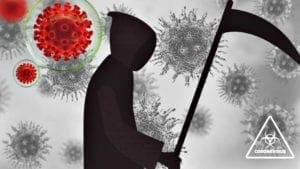Even after more than 500,000 dead worldwide, scientists are struggling to discern how often the COVID-19 coronavirus kills those infected by it.
– News covered by Quincy Quarry News with commentary added.
The Coronavirus Pandemic’s big mystery: how deadly is it?
The short answer: it is extraordinarily complicated to merely endeavor to project estimates.
After at least six months of the COVID-19 coronavirus probably jumping species from bats to humans, just how deadly is COVID-19 is but a working estimate as was recently reported in the New York broadsheet.
For example, while it is widely assumed that a considerable number – if not an overwhelming majority – of those infected by this particular coronavirus show few signs of it up to a point of unknowing but still contagious asymptotic infection. Just how many are asymptotic, however, is far from certain at this point in the pandemic.
Again, things are complicated.
Also generally known is that age and a wide range of preexisting conditions increase the virus’ lethality for those infected, but again certitude on these factors is currently also far from certain.
So too, it would appear, that having an A blood type significantly increases a person’s risk factor and blood types tend to vary in different parts of the world. For example, Type A blood is relatively rare in West Africa and South Asia, and very rare among the Indigenous peoples of South America as compared to the roughly 40% of Americans who have a Type A blood type.
Yet again, things are complicated.
All manner of complicated variables notwithstanding, at this point expert reviews of the data and better research studies indicate an “Infection Fatality Rate” of 0.64% and which the World Health Organization (“WHO”) only recently decided to use as its first official working projection.
While a small percentage, do note that a 0.64% fatality rate works to a potential worst case total of 2.13 millions deaths in the United States alone and roughly 50 million worldwide if everyone on Earth were to end up inflected.
On the other hand, the United States’ Center for Disease Control (“CDC”) relies on the “Case Fatality Rate” measurement approach and which the CDC notes ” … is not necessarily equivalent to the number of reported deaths per reported cases.”
Given determination criteria differences, the CDC’s case fatality ratio projection ends up calculating out to be 0.4%.
In turn, such works out to a worst case, everyone ends up infected projected maximum death toll of 1.3 million people in the United States.
That and roughly 30 million worldwide.
Granted, the almost forty percent lower CDC fatality rate projection yields a sizeable difference in the number of deaths from the projected death rate used by WHO; however, in the grand scheme of things, at this point these two projected fatality rates are relatively similar, especially after duly considering that both rates were determined by different measurement approaches.
Further note that early fatality rate projections for COVID-19 were in the 3% range, roughly 5 and 7 times greater than the current as well as relatively similar WHO and CDC projections, respectively.
And for a historical point of comparison, be sure to note that the 1918 worldwide influenza pandemic fatality rate is generally assumed to have been in the 2.5% range.
Granted, while the 1918 pandemic was probably 4 to 6 times more lethal than what is now projected for COVID-19, the effectiveness of healthcare has dramatically increased over the past hundred years and so blunted the potential lethality of COVID-19.
Again yet again, things are complicated.
And for a final complication: what are the implications of the fatality rate for each of the Earth’s 195 countries? After all, the inherent domestic demographic differences and the level of resources potentially available to each will force all manner of often hard decisions.
In poor countries where premature deaths from treatable chronic diseases are unfortunately difficult to merely but moderate, government officials and international aid sources will have to discern what is the best that can be done with what is both available as well as realistically possible.

Polio, measles, and other diseases expected to surge as COVID-19 forces suspension of vaccination campaigns in Third World countries
A Chiba Yasuyoshi image/AFP/Getty Images image
To whit, what sorts of resources should be secured to battle COVID-19 or might the better outcome for poor countries be to instead focus on – for but one example – endeavoring to vaccinate at least 93% of their populations so as to head off the variously problematic scourge that is measles and so achieve herd immunity.
In other words, triage on essentially a national scale.
And yes, determining the vaccination rate needed to secure herd immunity is both complicated as well as can vary greatly depending on the disease.
That and then there is the related problem of those who have not vaccinated their children in recent years over unfounded to irrational concerns about vaccines and so are betting their kids’ well-being as well as others in the hope that enough other children are vaccinated and will so provide enough herd immunity to protect their unvaccinated children.
So what if this irrational behavior only weakens the effectiveness of herd immunity on top of the fact that there are some people who for a variety of valid medical reasons cannot risk undergoing vaccination.
Yet again once more, things are complicated.
The takeaway: listen to the experts and if still unsure, do not flock to the bloviating sentiments of those who are not expert.
Source: The Pandemic’s Big Mystery: How Deadly Is the Coronavirus?





















QuincyQuarry.com
Quincy News, news about Quincy, MA - Breaking News - Opinion
No more posts